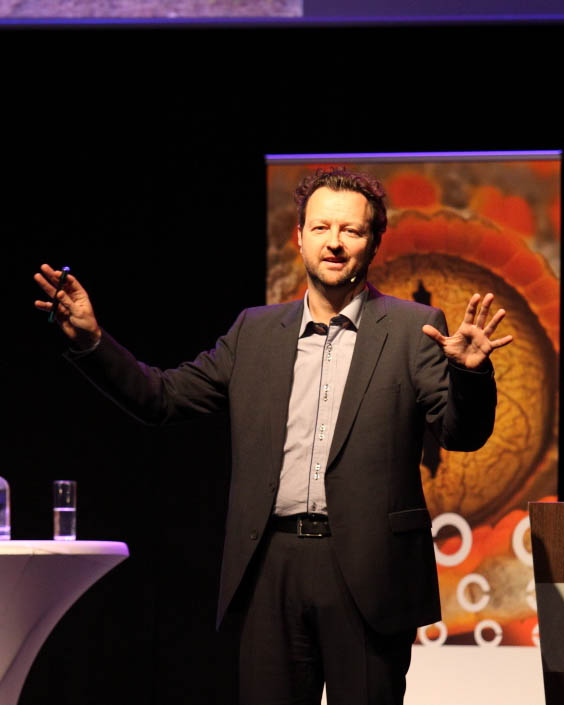PresbyHope
The Contamac Education Series 2019
By Eef van der Worp
As a young, fresh member of the 50+ family (sounds better than ‘old man’), I can confirm that presbyopia for me and my fellow generation is ‘a biggy’. We may be the first generation that grew up with contact lenses being the benchmark. In my high school years, the vast majority of kids needing a prescription wore some kind of lenses – rigid gas permeable or soft lenses (probably about equally split) – but not glasses.
There is not a (gray) hair on our heads, generally speaking, that even considers going back to glasses, not even when the reading problems kick in. At least, that is what we want – and what we seek. But is this attainable, and is our current ‘glasses-free ’ lifestyle sustainable?
“is the current ‘glasses-free ’ lifestyle for young presbyopes sustainable?”
If you look at the data – it is stunning to see that the need for refractive correction increases to 100% at 50 years of age while it is only 50%-60% at age 40. At the same time, a steady decrease in contact lens wear sets in – in fact it halves, from 20% lens wearers at age 40 to only about 10% at the age of 55 (data available: Mile Brujic’s article.)
Easy Fix
This proves that there is no easy fix to solve this problem – both the opportunities, as well as the challenges, are huge. Enough about the opportunities – every lecture on the topic always starts about the humongous potential that presbyopic patients have in contact lenses: there is no easy fix, and this is what we should focus on. This article seeks to summarize the latter in a nutshell.
Among the factors that influence the decline in presbyopes wearing contact lenses, we first need to look at ‘comfort’. End-of-day comfort is always an issue, in all kinds of lens wear and most probably in all lens modalities. It may be a tad more of a problem in presbyopes, but nothing significant changes to the anatomy or even the physiology, other than a slightly less stable tear film. Moreover, it is a factor we can hardly influence.
The thing is that, typically, end-of-day discomfort is taken for granted and accepted as the freedom of not having to wear frames and glasses. To be able to show your own natural face, without the cosmetic visibility of any medical device, is such huge plus. Before you know it – my generation thinks of hearing aids and rollators next; glasses are only the start. In addition, the freedom from glasses in various sporting and outdoor activity is unchallenged, and my generation, in general, is fit and active enough (or at least we think we are), for this to be an important factor.
Vision
However, if end-of-day comfort is combined with sup-optimal vision, then the sum is not typically 2, but more than that: it is overwhelming. The easy fix is going back to glasses, to solve all of the problems.
The sub-optimal vision challenge is fun to explain. What we try to do, is to put extremely complex optics in a medical device. In glasses, at least we have some room to work. In contact lenses, the playroom is much smaller – and to our dismay, we cannot use the full 14.2mm of the soft lens diameter, we are limited to the small pupil diameter of about 6mm max! It is even smaller in reality. Within that narrow space, we want both far and near optics – either simultaneously or alternatingly. Interesting fact: pupil size decreases with age, called ‘senile miosis’ in medical terms. Great. That really helps.
Corneal GPs
Optically, corneal GPs have the ‘best of both worlds’. They can provide superb optics (in rigid lens materials) and have the option to move on the eye, which allows for alternating optics. This means that with the gaze, the optics of the lens change over the pupil zone. In distance gaze, the optics of the lens representing distance correction is provided – in downgaze the lens optics ‘switch’ to near optics for the desired working task that is pre-determined.
In addition, corneal GPs offer the best oxygen permeability to the cornea and are by far the safest lens option out there. So far the theory and practice reveal that comfort is sub-optimal with corneal GPs in many patients’ experience, and the lens is not the best-selling device on the market, to put it mildly. But as eye care practitioners (ECPs) we should keep in mind that the options with both simultaneous and alternating corneal GPs are superb.
Sclerals
Scleral lenses have one of the two benefits that corneal GPs have: they have superior optics. The optics of scleral lenses are actually even more stable than corneal GPs – making the image quality more stable on the eye. They do not translate on the eye though (as they don’t move much) making alternating scleral lens designs virtually impossible. Hence, in the scleral lens arena, we are confined to simultaneous designs – yet with very stable optics.
This is still a growing market, but probably mostly in the specialty lens arena. If the patient is wearing a scleral lens already, then multifocals could be a great solution if needed – and ECPs could most probably be a bit more proactive offering this solution. To summarize it up in a quote from a colleague of mine: ‘keratoconic patients become presbyopic too you know’. But I doubt this will be an overall solution to the presbyope in the general public, not wearing sclerals.
Soft Specialty
There is no doubt that the biggest opportunity lies within the soft lens arena. Eurolens Research surveys show that soft lenses account for pretty much 90% of all lens fits world-wide. However, currently available soft stock lenses have unfortunately not lived up to the task. With all these great lenses available, the decline in contact lens wear in the presbyopic population has set in. The people that are happy in their current multifocal soft lenses, we should not touch. But we need more. And I think – whether we like it or not – there is only one possible solution. I don’t see any stock lenses coming on the market soon that will revolutionize presbyopic lens fitting with soft lenses.
As opposed to corneal GPs – soft lenses have actually two disadvantages: they do not have stable optics and they do not have the option to ‘translate’. There have been two alternating soft lenses on the market to date, but not very successful it seems. A new prototype entering the market soon may change this for the better hopefully.
Decentered Optics
In essence, we are ‘stuck’ with simultaneous designs – with questionable optics because of the soft nature of the hydrophilic materials they are made of. In addition, there is one other limitation that we have not touched on. That is to center the optics of the lens over the line of sight of the eye. In short, what we know, is that typically the pupil is decentered nasally from the geometric center of the cornea. In addition, the line of sight of the eye is slightly more nasally centered compared to the geometric center of the cornea. A standard soft lens that centers well on the cornea, therefore, does not have perfect alignment with the line of sight, which is what is desired. On top of things, we now know (from scleral lens research) that the nasal portion of the scleral anatomy is typically flatter, hence we see by default a slight temporal decentration of the soft lens on-eye. The nasal displacement of pupil and line of sight is therefore amplified by the temporal decentration. In essence – the already complex optics concentrated in a very narrow space is also typically not in the right location.
Tailor Mates
To counter the latter, the only step up that I see, and hope that I have for the presbyope, is to decenter the optics of soft multifocal lens, and in general to get more to grips on lens fit (to counter or compensate decentration potentially). In conclusion, this means there is room for customized soft lenses in the presbyopic arena. The only way to really help our generation with their visual demands is to measure the eye in detail – both shape, with new ocular surface devices, and complex optics with aberrometers etc, and then to put these optics right there where you want or need them: in front of the pupil and on the line of sight. Presbyopic contact lens correction can only be successful, on a larger scale, if we customize the lens – in other words, if we become ‘tailor mates’ for my generation.
World Wide Education Series
Soft lens fitting and customization of soft lenses is one of the most popular presentations – among other specialty lens topics such as sclerals and corneal GPs and orthokeratology – as part of the Contamac World Wide Education series, provided by Eef van der Worp and presented at various occasions and venues globally. The 2019 education series included lectures at conferences around the world, including Santiago de Chile (Chile), Buenos Aires (Argentina), Bern (Switzerland), Västerås (Sweden), Las Vegas (US), Brussels (Belgium), Almeria (Spain), Houten (the Netherlands) and Manchester (UK) – and included helping and supporting PhD students on specialty lens topics, such as corneal GPs and sclerals. It also provided remote live webinars at schools in Bloemfontein (SA), Montreal (CA) and Pacific University (Oregon, US).

SoftSpecialEdition
In the quarterly newsletter, softspecialedition.com, kindly sponsored for many years by Contamac, topics like accommodation, presbyopia and multifocal challenges are frequently discussed among peers, showing the latest research in the field.
Among them, a recent column (Spring 2019 edition) titled ‘Understanding Multifocal Soft Lenses Optics’ with subtitle by Miguel Faria Ribeiro, researcher at the Clinical and Experimental Optometry Research Lab, University of Minho, Braga, Portugal cover the topic, and focused on increasing the success rate of multifocal soft lenses by introducing custom made power profiles.
‘When Quantity and Quality of Vision Don’t Add Up’, was a column about the frustrating visual demands of presbyopes and the challenges of soft multifocal lens fitting in the winter 2019 edition, by Stephanie Ramdass who is in private practice in Toronto (CA) and adjunct faculty member Michigan College of Optometry (US).
In the current (winter) edition of softspecialedition.com, Bernd Brückner – optometrist and working for a specialized contact lens manufacturer in Switzerland – with a column focused on the fitting of soft, multifocal-concentric contact lenses with a decentered near zone as a solution for insufficient performance with conventional multifocal contact lenses. Soft lens options for the not so standard eye are the main topics of the newsletter.
To sign up for free, or to visit the archive please go to SpecialSoftEdition.com.
Related articles:
The Contamac Education Series 2018
The Contamac Education Series 2017

Eef van der Worp is an educator and researcher. He received his optometry degree from the Hogeschool van Utrecht in the Netherlands (NL) and has served as a head of the contact lens department at the school for over eight years. Eef received his PhD from the University of Maastricht (NL) in 2008. He now runs his own research & education consultancy ‘Eye-Contact-Lens’ which is based in Amsterdam (NL). He is a fellow of the AAO, BCLA and the SLS, a lifetime fellow of IACLE and an honorary life member of ANVC. He is on the education committee for the GSLS and the OVN. Eef is adjunct assistant Professor at Pacific University College of Optometry (Oregon, USA), and adjunct Professor at the University of Montreal University College of Optometry (CA) and he is lecturing extensively worldwide and is a guest lecturer at a number of Universities in the US and Europe.
More by Eef van der Worp:
